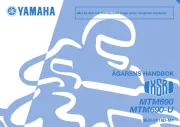Yamaha TT-R50EA (2010) Bruksanvisning
Läs gratis den bruksanvisning för Yamaha TT-R50EA (2010) (84 sidor) i kategorin Motor. Guiden har ansetts hjälpsam av 14 personer och har ett genomsnittsbetyg på 4.8 stjärnor baserat på 7.5 recensioner. Har du en fråga om Yamaha TT-R50EA (2010) eller vill du ställa frågor till andra användare av produkten? Ställ en fråga
Sida 1/84

1P6-F8199-85
TT-R50E
TT-R50EA
OWNER’S MANUAL
MANUEL DU PROPRIÉTAIRE
BEDIENUNGSANLEITUNG
Il convient de lire attentivement ce manuel avant la pre-
mière utilisation du véhicule.
Bitte lesen Sie diese Bedienungsanleitung sorgfältig
durch, bevor Sie das Fahrzeug in Betrieb nehmen.
Read this manual carefully before operating this vehicle.
Produktspecifikationer
| Varumärke: | Yamaha |
| Kategori: | Motor |
| Modell: | TT-R50EA (2010) |
Behöver du hjälp?
Om du behöver hjälp med Yamaha TT-R50EA (2010) ställ en fråga nedan och andra användare kommer att svara dig
Motor Yamaha Manualer

16 Februari 2025

2 Februari 2025

4 Januari 2025

4 Januari 2025

31 December 2025

27 Oktober 2024

1 Oktober 2024

28 September 2024

23 September 2024

23 September 2024
Motor Manualer
- Mahindra
- Metabo
- Hero
- Juki
- Sherco
- Aprilia
- BodyCraft
- Victory
- Zero
- Mercedes-Benz
- Kettler
- Anova
- BMW
- Triumph
- Indian
Nyaste Motor Manualer

1 Mars 2025

22 Februari 2025

18 Februari 2025

17 Februari 2025

16 Februari 2025

15 Februari 2025

14 Februari 2025

8 Februari 2025

8 Februari 2025

8 Februari 2025